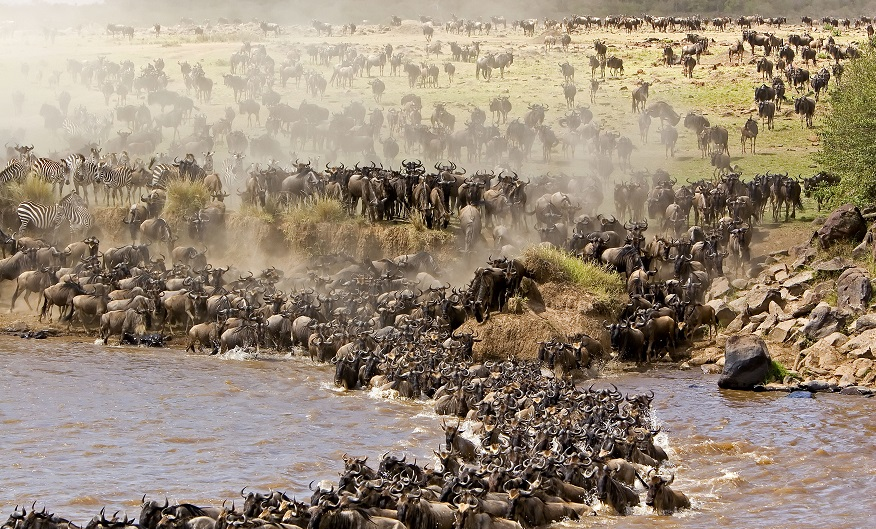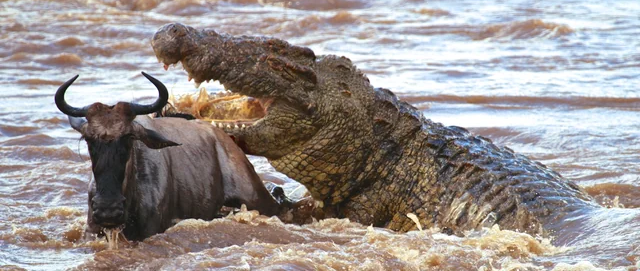- Overview
- Trip Outline
- Trip Includes
- Trip Excludes
- Gallery
- Reviews
- FAQ
Our 4 Days Detailed Great Migration in Kenya Safari Experience Itinerary
Wildebeest Migration Wonder of the World - Masai Mara Migration Price, Itinerary, & More
The Kenya wildebeest migration is undoubtedly the world's most facilitating occurrence. Annual migration of millions of wildebeests, zebras, antelopes, and other grazers between the Serengeti National Park and the Masai Mara Game Reserve.

Scientists don't know how the wildebeests know when to migrate or how they know where to go. One intriguing idea is that they follow the fragrance of the rain.
If you want to witness the world's greatest wildebeest migration, we recommend visiting Kenya between July and late September, when the animals will be in the Masai Mara.
You're probably wondering how much wildebeest migration safari packages cost. Several variables impact the cost, including the length of your stay and the kind of lodging.
This evaluation will provide you with a thorough summary to aid you in your planning.
Most importantly, you're probably curious about how a migration safari works, what occurs in the Masai Mara, and what it's like to see hundreds of wildebeest cross a crocodile-infested river.

We were fortunate enough to see the Masai Mara migration, and we are delighted to share our first-hand description of the most spectacular spectacle on earth with you.
That is exactly what we have done with our 3-day or 4-day Kenya wildlife migration safari packages and itinerary.
Wildebeest Migration in Kenya – Book Your Great Migration Safari Today With Goldstep Safaris www.goldstep.africa

Your Kenya wildebeest migration safari starts here. Book the packages in this piece or customize your safari by calling us or sending a WhatsApp message to +254-115-655-877.
We are also available through email
The world's most sought-after game reserve, Masai Mara, is approximately two hours drive away from here. We can all sense the excitement rising as we approach the reserve's gates because this is the best time to visit.
If you were returning home, we would normally drive you back to Jomo Kenyatta International Airport during a trip with guests.

We return you to your Nairobi hotel or take you to your next destination if you are visiting other parts of Kenya.
Kindly see the detailed itinerary.
Itineraries
Day 1
Arrival in Nairobi, transfer to Masai Mara, and evening game drive.
We leave Nairobi bright and early, as we typically do on Masai Mara road trips. The majority of our clients arrive in Nairobi before 4 a.m. We pick them up at the airport and begin the journey at 6 a.m.
This is to ensure that we arrive in time for lunch and an early evening game drive in the Masai Mara. We exit Nairobi via the Southern Bypass and join the Nairobi-Nakuru route.
The Great Rift Valley View Point, which is approximately an hour away from Nairobi, is usually our first destination on the trip.
You can see the enormous expanse of the Great Rift Valley stretching as far as your eyes can see from this captivating location. There are many curio stores where you can begin purchasing mementos for your loved ones.
We head back out onto the road after snapping the customary first pictures of the journey. Narok Town will be our next destination.
We travel to Narok town in two or three hours. Some guys take advantage of the chance to stretch their legs, others make a bathroom stop, and still others shop for last-minute items.
The world's most sought-after game reserve, Masai Mara, is approximately two hours drive away from here. We can all sense the excitement rising as we approach the reserve's gates because this is the best time to visit. After paying, we check into our park lodging and spend the next three or four days at our home.
We check in and are greeted warmly with a glass of chilled mango juice or other refreshments. When we have guests, we usually let them unwind and refresh for the remainder of the afternoon before heading out for an evening game drive.
Game drives in the evening present excellent opportunities to see a hunt as the predators search for their prey. The upcoming days will be incredible!
Day 2
Enjoy Migration with a Full-Day Game Drive at Masai Mara National Reserve We meet for breakfast early on the second day.
We all slept soundly with the sounds of various wild animals resonating in the distance after the exhausting journey of yesterday. Although the buffet is delicious, we don't stay long.
We don't want to miss another second of this massive migration. We are having a packed lunch today, kindly provided by the hotel, as a result. That means we won't be coming back for lunch because we will be gone all day.
After gathering our belongings, we make our way to the Mara River, the hub of activity. Along the way, we come across antelopes, gazelles, zebras, hundreds of wildebeest who have already made the lucky cross, and many other species.
From a distance, we can hear the sounds, excitement, and buzz as we get closer to the Mara River. When the animals leap into the unknown waters, they make a loud splashing sound.
Here, safety lies in numbers, and hundreds of wildebeest pass through. We park our van next to other tour vans and use the open roof to set up our equipment.
We are soon captivated by the action occurring below. Some of the animals slip and land with their heads first in the water as they descend the steep slopes of the elevated banks. Countless others stand by the banks, and gradually, they enter one by one.
wild beast
For some, the steep ascent out of the water is challenging, but soon they will launch toward a patiently waiting pride of lions. Abruptly, we spot movement in the center of the river.
Three large crocodiles have taken a zebra as prey, and no matter what it does, it will not prevail in this fight.
We lose track of time as we become absorbed in the action. We know it's lunchtime because of the growling in our stomachs.
We make our way to a well-liked picnic area close to the Mara River, where we marvel at what we just saw while chowing down on chicken sandwiches and refreshing juice.
Looking through all of the pictures will be a lot of fun.
We return to the hotel exhausted yet captivated as the afternoon fades into dusk.
I'm excited for a cold beer and a warm bath. Tomorrow is going to bring new experiences.
Day 3
Optional Hot Air Balloon Safari Followed by Full-Day Migration Safari – Experience the Migration
Day three in Kenya typically consists mainly of the second day's great migration, but with an early morning hot air balloon ride over the Masai Mara.
The only experience that compares to hot air ballooning over Masai Mara is a helicopter safari. Start your day with this one- to two-hour ride over the dotted Mara, which culminates in a champagne breakfast served in the middle of the jungle.
The morning pick-up from the lodging kicks off the operation at approximately five in the morning. Approximately 9.30 am is when it ends. It's time to go on our game drives.
We spent some time exploring the remainder of the park today, away from the Mara River. Now that several animal herds have crossed, the park is humming with activity.
The wide, verdant plains are teeming with both predators and prey, wherever we turn.
A lone leopard perches a tree, and we come across a herd of elephants near some acacia trees. We return to the camp at dusk after another successful day.
Day 4
Morning Game Drive, Visit a Maasai Village, and Transfer to Nairobi
On our final day at the Masai Mara, we get up after breakfast and check out of our rooms as usual. As we leave the park on this final day, we will go on one last game drive.
This is a fantastic opportunity to see anything we might have overlooked while here. As for us, we leave and immediately return to the Mara River to see some action.
With so much to see, it doesn't seem like 10 am when we have to drive out of the park to visit a Maasai village.
Over the years, we have developed friendships in the village, and we frequently visit to check on them.
Kilusu, the village chief, amuses us as usual with stories told in broken Swahili and English, which quickly makes us laugh uncontrollably. During our scheduled Masai Mara safari visits, we always make arrangements for our clients to visit a Masai Village and engage with this distinctive Kenyan tribe. To this day, the Maasais obstinately maintain their customs in the face of change.
Sheep and soil are still used by women to build manyattas or traditional homes, and young boys are mostly responsible for herding goats and cattle. Maasai morans, or warriors, dress up and perform songs and dances for our guests.
The majority of visitors who wish to try it find the renowned Masai jump to be especially fascinating. Typically, this is an excellent opportunity to purchase genuine jewelry crafted from beads and other conventional materials.
The lengthy 5-hour drive to Nairobi then starts. We occasionally experience some traffic on the highway, but we arrive in Nairobi safely and exhausted.
If you were returning home, we would normally drive you back to Jomo Kenyatta International Airport during a trip with guests.
We return you to your Nairobi hotel or take you to your next destination if you are visiting other parts of Kenya.
- Pick up from JKIA on day 1
- Services of a professional safari guide
- Bottled mineral drinking water during the safari
- Exclusive use of a 4×4 safari land cruiser
- All park fees and government taxes
- Full-board accommodation at Masai Mara for three nights on sharing basis
- Game drives at Masai Mara on day 1
- Full-day game drive at Masai Mara on day 2
- Full-day game drive at Masai Mara on day 3
- Game drives at Masai Mara on day 4 when staying inside the reserve
- Visit a Maasai village on day 4
- Transfer to Nairobi (JKIA) on day 4
- A hot air balloon safari – USD 475 Per Person
- Tips and gratuities to safari guide
- Local and internal flights
- Laundry services
- Visas
- Money transfer fee
The great wildebeest migration takes place in Kenya between July and October. At this time, thousands of wildebeest, zebras, antelopes, and eland will have circled back from Tanzania’s Serengeti Game Reserve, arriving at the Mara River in July.
However, there is no set date when the migration begins and ends, as the animals have intrinsic knowledge of when to move to the Masai Mara and when to go back to the Serengeti.
Ideally, the best time to visit Kenya is between July and October, when the wildebeest migration occurs. However, Masai Mara is a vast, wildlife-rich park that will thrill you regardless of what time of the year you visit.
In other words, you will still see numerous animals and have a wonderful trip, no matter the time of the year. Spending Easter, Christmas, or New Year in the wild can be remarkable.
Several factors determine the cost of a Kenya animal migration safari or Masai Mara migrations safari. One of these factors is the duration of your stay. The longer you stay, the higher the cost.
Another factor is where you stay. The Mara has all types of accommodation, ranging from budget to super luxurious. Again, your preferences here will determine costs.
The means of transport is another factor. Flying, for instance, is faster but more expensive. If you are going by road, taking a 4*4 safari jeep/land cruisers will be more costly than a nine-seater open rooftop van.
Lastly, if you want to enjoy extra activities such as a balloon ride, helicopter excursion, or romantic bush dinner, these may push your cost higher.
On average, this is an example of how much you can expect to spend at the Masai Mara for two people sharing.
• A budget Kenya migration Safari package costs anything from $300 per person sharing per day.
• A mid-luxury Kenya migration safari package costs as little as $450 per person sharing per day.
• An all-inclusive luxury Kenya migration safari package costs anything from $700 per person per day
As mentioned, the Masai Mara is a vast park. During the wildebeest migration in Kenya, we recommend that you plan a minimum of 3-night or 4-day. Of course, the longer you stay, the more chances you will see more, particularly during the great migration.
If you are short of time, we advise a minimum of two nights at the very least.
There are two main ways of getting to the Masai Mara, and we can arrange either based on your preferences. First, you can fly to the Masai Mara from Nairobi’s Wilson Airport. This takes about 45 minutes.
The second option is to go by road, which takes about six hours, either by a 4*4 land cruiser or pop-up van. You can hire a private van for your party or share it with other guests for the road trip.







There are no reviews yet.